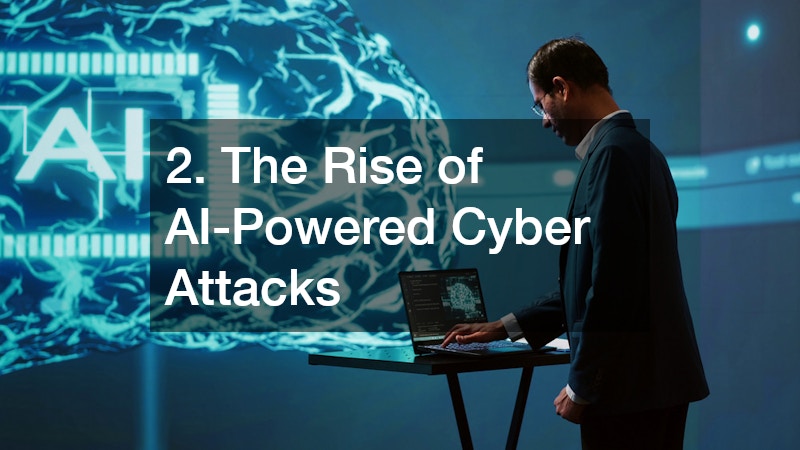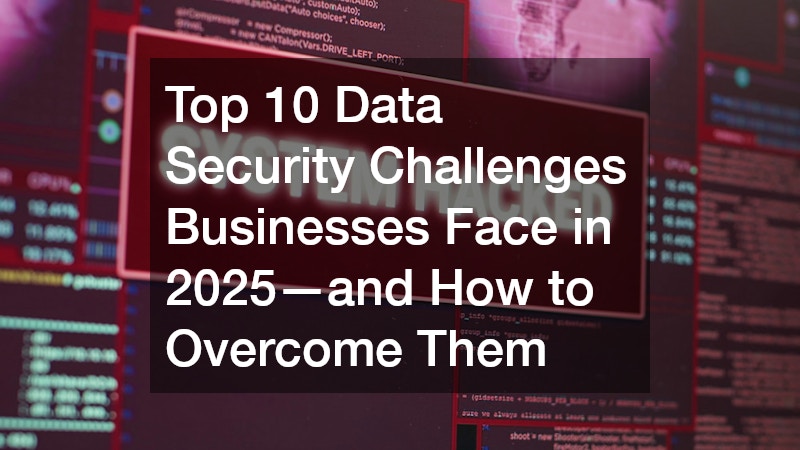Disclaimer: This website shares legal information for educational purposes only and does not constitute legal advice. Please consult a licensed attorney for advice specific to your situation.
In the ever-evolving digital landscape, data security is more than a buzzword—it’s a core necessity for any modern business. As companies become more reliant on cloud services, remote work, and AI-powered systems, the risk of cyberattacks grows exponentially. Cybercriminals are becoming more sophisticated, and traditional defenses often fall short.
By 2025, businesses will face new and intensified data security challenges that threaten their operations, reputations, and customer trust. Whether you’re running a small company or managing a large enterprise, understanding these threats and taking proactive steps is critical.
This article explores the top 10 data security challenges businesses will face in 2025 and offers actionable strategies to help you stay protected. From ransomware attacks to insider threats, we break down what to watch for and how to defend your company effectively.
1. Ransomware Attacks Are Getting Smarter—Are You Prepared?
Ransomware remains one of the most dangerous cyber threats, and in 2025, it’s expected to become even more advanced with AI-driven attack vectors. Hackers no longer target just large corporations—they increasingly go after small and mid-sized businesses that often lack strong defenses.
How to Overcome This Challenge:
- Invest in Endpoint Detection and Response (EDR) tools.
- Back up data regularly and store copies offline.
- Train employees to spot phishing emails and suspicious links.
- Implement zero-trust security protocols to limit lateral movement during an attack.
2. The Rise of AI-Powered Cyber Attacks

As businesses adopt AI for automation and analytics, cybercriminals are using it too. AI-powered attacks can identify system vulnerabilities faster, craft believable phishing emails, and bypass traditional detection tools.
How to Overcome This Challenge:
- Use AI-driven threat detection tools to match the speed of attackers.
- Regularly update your software and security patches.
- Conduct penetration testing to identify weaknesses before hackers do.
- Collaborate with cybersecurity vendors who specialize in AI threat analysis.
3. Third-Party Vendor Risks: How Secure Are Your Partners?
Supply chain and vendor-related attacks are on the rise. In many cases, your data security is only as strong as your weakest partner. From payment processors to cloud providers, any third party with access to your systems can become a vulnerability.
How to Overcome This Challenge:
- Establish a vendor risk management policy.
- Require security certifications (like SOC 2 or ISO 27001) from vendors.
- Conduct annual security audits for all third-party services.
- Limit vendor access to only the data and systems they need.
4. Insider Threats Are Harder to Detect
Whether malicious or accidental, insider threats remain a significant risk. These threats are difficult to catch because they come from people who already have legitimate access to your systems—employees, contractors, and even executives.
How to Overcome This Challenge:
- Implement user behavior analytics (UBA) to detect anomalies.
- Set up role-based access controls.
- Conduct exit interviews and revoke access immediately after employment ends.
- Promote a culture of accountability and security awareness.
5. Remote Work and BYOD Policies Are Expanding Attack Surfaces
The shift to hybrid and remote work is here to stay. But with that flexibility comes risk, especially when employees use personal devices or unsecured networks to access business data.
How to Overcome This Challenge:
- Enforce mobile device management (MDM) policies.
- Require VPN use for all remote work.
- Provide company-approved devices or endpoint security software.
- Educate staff on safe remote working practices.
6. Data Privacy Regulations Are Increasing Worldwide
New and stricter data privacy laws—like the EU’s GDPR, California’s CCPA, and others across Asia-Pacific—are forcing businesses to rethink how they collect, store, and protect customer data. Non-compliance can lead to massive fines and loss of trust.
How to Overcome This Challenge:
- Hire or consult with a data privacy officer or compliance expert.
- Maintain an up-to-date data inventory.
- Automate compliance processes using governance, risk, and compliance (GRC) software.
- Be transparent about your data collection and storage policies with customers.
7. Cloud Security Misconfigurations Continue to Plague Businesses
(Includes the keyword: “data security challenges”)
Cloud adoption offers flexibility and scalability, but it comes with its own set of data security challenges, especially misconfigurations. A minor mistake in access control settings can expose sensitive data to the internet.
How to Overcome This Challenge:
- Conduct regular cloud security assessments.
- Enable multi-factor authentication (MFA) for cloud services.
- Use cloud security posture management (CSPM) tools.
- Train your IT team in secure cloud architecture best practices.
8. Social Engineering Attacks Are More Convincing Than Ever
In 2025, expect phishing emails, voice phishing (vishing), and even deepfake impersonations to become more convincing and dangerous. These attacks prey on human error and trust rather than technological weaknesses.
How to Overcome This Challenge:
- Run simulated phishing campaigns to train employees.
- Educate staff on common social engineering tactics.
- Require dual approvals for sensitive requests (e.g., wire transfers).
- Install spam filters and secure email gateways (SEGs).
9. Lack of Skilled Cybersecurity Talent
Even with the right tools, a lack of trained cybersecurity professionals puts businesses at risk. The global cybersecurity workforce shortage continues, making it hard to find and retain experts.
How to Overcome This Challenge:
- Outsource to managed security service providers (MSSPs).
- Offer cybersecurity training and upskilling for current IT staff.
- Use automation and AI tools to reduce the workload on security teams.
- Partner with local universities or bootcamps to build a talent pipeline.
10. Data Fragmentation Across Multiple Platforms
With data spread across CRMs, marketing platforms, ERP systems, and more, managing and securing it becomes increasingly complex. Fragmented data increases the risk of breaches and compliance violations.
How to Overcome This Challenge:
- Consolidate data where possible using integrated platforms.
- Implement data classification and tagging.
- Use data loss prevention (DLP) tools to monitor and control sensitive data flows.
- Appoint a data governance lead to coordinate policies across departments.
Building a Resilient Cybersecurity Strategy for 2025

While the challenges may seem daunting, awareness and preparation are your best defenses. Data breaches can be financially devastating and damaging to your brand, but many attacks are preventable with the right strategies.
Business owners should think of cybersecurity not as a one-time investment, but as an ongoing process that evolves alongside digital threats. Regularly assess your security posture, train your employees, and work with experts who can help you stay one step ahead.
By addressing these top data security challenges head-on, you can safeguard your business and build long-term resilience in an increasingly connected world.
From Reactive to Proactive: Shifting the Security Mindset
One of the biggest takeaways for 2025 and beyond is the need to move from a reactive to a proactive cybersecurity mindset. It’s no longer enough to patch systems after a breach or rely on outdated antivirus software. Cyber resilience requires forecasting potential threats, conducting risk assessments, and building redundancies into your infrastructure.
Proactive companies simulate attacks through red team exercises, maintain incident response playbooks, and build cross-functional cybersecurity task forces that include IT, HR, compliance, and executive leadership. This holistic approach ensures that everyone plays a role in protecting sensitive data.
Cybersecurity Is Everyone’s Responsibility
In 2025, cybersecurity will not be confined to the IT department—it will be a company-wide responsibility. Every employee, from interns to the CEO, must understand the impact of poor digital hygiene. Most breaches still stem from human error, which makes employee education one of the most critical defense layers.
Companies should implement quarterly cybersecurity awareness training, integrate security tips into onboarding processes, and encourage a culture where reporting suspicious activity is the norm. Gamification and incentives can also be effective ways to keep security a priority for employees.
Case in Point: The Cost of Ignoring Security Fundamentals
Consider the case of a mid-sized marketing firm that suffered a major data breach in early 2024. A compromised third-party SaaS vendor led to the exposure of over 50,000 client records. The company not only faced regulatory fines under the GDPR but also lost several high-value clients due to diminished trust. A later investigation revealed that the vendor did not follow standard access control protocols—a gap that could have been flagged during a routine third-party risk assessment.
This example underscores the importance of vigilance and routine security evaluations, especially as tech stacks become more complex and interconnected.
Investing Wisely: Where to Focus Your Cybersecurity Budget
If budget is a constraint, prioritize investments that yield the highest impact:
- Identity and Access Management (IAM): Ensure only the right people have access to the right systems at the right time.
- Security Information and Event Management (SIEM): Centralize threat detection and response using real-time analytics.
- Cloud Security Tools: With more data moving to the cloud, tools like Cloud Access Security Brokers (CASBs) and CSPM platforms are crucial.
- Data Encryption: Encrypt data at rest and in transit to protect against breaches and leaks.
Additionally, don’t overlook cybersecurity insurance. While it’s not a substitute for strong security practices, it can provide financial support and risk mitigation in the event of an incident.
The Future of Cybersecurity: Embracing Automation and Zero Trust
Looking ahead, automation and zero-trust architecture will dominate the cybersecurity conversation. Automated tools can help detect threats faster than human teams can respond, while zero-trust assumes that no device or user should be trusted by default, even if they’re inside your network.
Microsegmentation, continuous authentication, and adaptive access controls are all part of this model, enabling businesses to limit exposure and isolate incidents before they escalate.
Conclusion: Strength Through Vigilance and Innovation
Cybersecurity in 2025 is not just about protecting data—it’s about preserving your business’s future. As cyber threats evolve, so too must your defenses. By staying informed, investing strategically, and fostering a security-first culture, you position your company to face any challenge with confidence.
The businesses that thrive in this digital era will be those that see cybersecurity not as an obstacle but as a catalyst for growth, trust, and innovation. Stay alert. Stay adaptive. And above all, stay secure.


